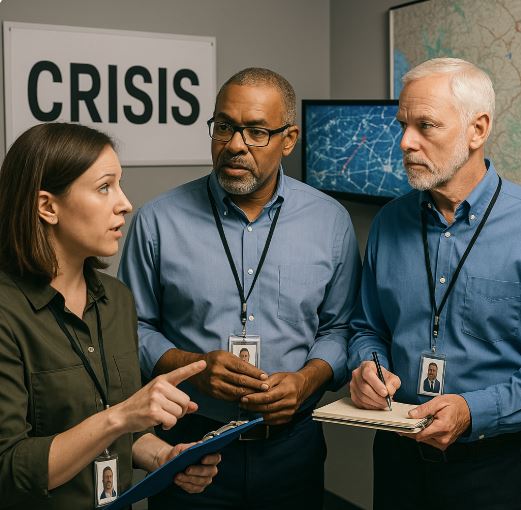


Crisis Communications: Before, During, and After Disasters
By Dan Stoneking, Dr. Joseph V. Trahan III, Scott Thomsen, and Justin Graney, writing for Homeland Security Today
In all the years that we’ve published Crisis Communications Today,
we don’t believe we’ve ever written “This is a MUST-READ.”
This one is.
Which came first, the classroom or the disaster? It doesn’t matter. They are interwoven and interdependent in a constant cycle of learning, executing, and learning more. Wash. Rinse. Repeat. I reached out to three highly-respected crisis communicators and asked them to share examples of how the classroom effectively informed crisis communications in a disaster and how the disaster experience then informed future classroom curriculum. While each of these individuals have different years and geography of experience, they all have one thing in common – a clear understanding of crisis communications in both the classroom and in a crisis.
From the Classroom to the Bridge in Eight Steps (Trahan)
On March 26, 2024, the historic Francis Scott Key bridge was destroyed by the M/V Dali killing 6 people and blocking all commerce in and out of the port of Baltimore.
The USACE Baltimore district and Public Affairs Officer (PAO) Chief Kurt Raushenberg, Public Affairs Specialist (PAS) Bobby Petty from the USACE Galveston district, and Public Information Officer (PIO) Kasey Thomas, representing Anne Arundel County, all were assigned to the unified command’s Joint Information Center (JIC) to support the Key bridge recovery efforts. All three recently completed the FEMA certified Master Public Information Officer (MPIO) program now called the Executive Public Information Officer (EPIO) course.
All three immediately used the eight step strategic communications model that they had been taught during their FEMA Advanced PIO course and reinforced during their FEMA MPIO/EPIO courses. They (1) assessed the current situation, (2) set communication goals, (3) identified intended audiences, (4) developed and pretested messages, (5) developed channels and activities, (6) developed an action plan, (7) re-developed and pre-tested materials and implemented, (8) evaluated and modified their plans.
Their proactive communication strategy of getting senior leaders to be the face and voice of their response at the local, regional and national level to provide the latest information to their direct publics during the recovery at least three times daily earned them trust from the public. Additionally, they recognized the need to communicate directly with their Spanish speaking public. The public affairs team’s three month content results were: 61 videos, 1,036 images, six stories, 15 graphics, five news releases, 6,300 downloads and 283,000 views from news outlets and the public on the Defense Visual Information Distribution Service (DVIDS). The FEMA PIO/EPIO course that Tom Olshanski and Phil Politano established years ago proved the value of highly trained MPIO/EPIOs for all organizations.
USACE Baltimore district commander Col. Estee S. Pinchasin observed, “Throughout this response, I saw the true value and reaffirmed my strong belief in our public affairs capabilities in times of crisis, especially in today’s ever evolving news media world, it’s the work that these professionals perform that can make the organization’s trust and transparency with the public a true success and I can’t thank them enough for their accomplishments.”
The classroom prepared them for the disaster. Their disaster experience informs the next classroom.
No “Thoughts and Prayers,” not in Nashville, not Anywhere (Thomsen)
A common theme in many public information officer courses is to deliver authentic statements of empathy for communities affected by tragedy or disaster, not the cliché “thoughts and prayers” that comes across as insincere.
In 2023, a student at a Nashville high school shot two other students, killing one, before turning the gun on himself.
At a news conference where police and other officials described the events and the investigation while trying to comfort a shocked community, the police chief found an effective way to deliver his faith-based support. The chief had been prepped for the news conference by a FEMA-trained PIO, who counseled him to avoid the cliché.
When he got to the podium, the chief said he knew that he wasn’t supposed to say, “thoughts and prayers,” but he believed in the power of prayer and was praying for the victims, their families and others affected by the shooting.
That chief accomplished a deep, authentic expression of empathy by demonstrating the faith behind his statement. He put meaning to it, rather than using what has become an emotionless throwaway line in so many instances.
The bottom line is that when expressing empathy, any lack of sincerity or authenticity will be recognized immediately. Such statements are actually worse than not saying anything at all. To be effective, PIOs and leaders put thought into what they say so they can genuinely offer emotional support for others. We cannot fake sincerity, nor should we ever try.
Again. The classroom taught this essential approach. This example from the Nashville shooting response will make that lesson even deeper for the next class.
For the rest, click here.